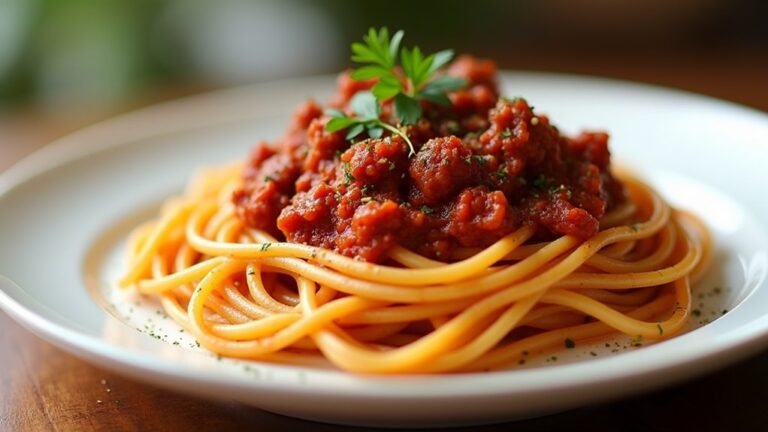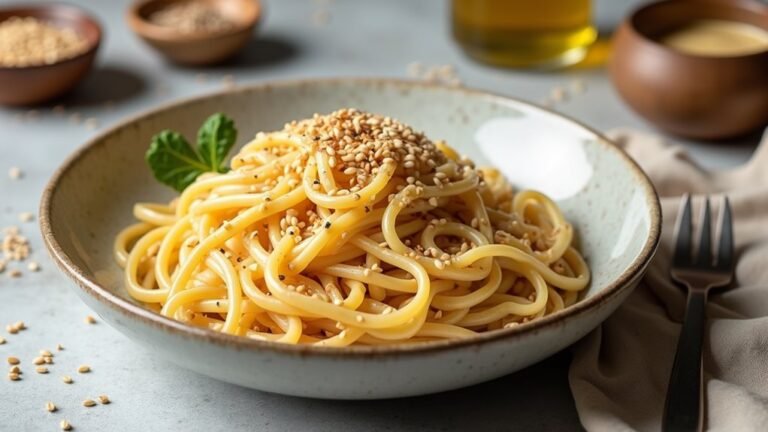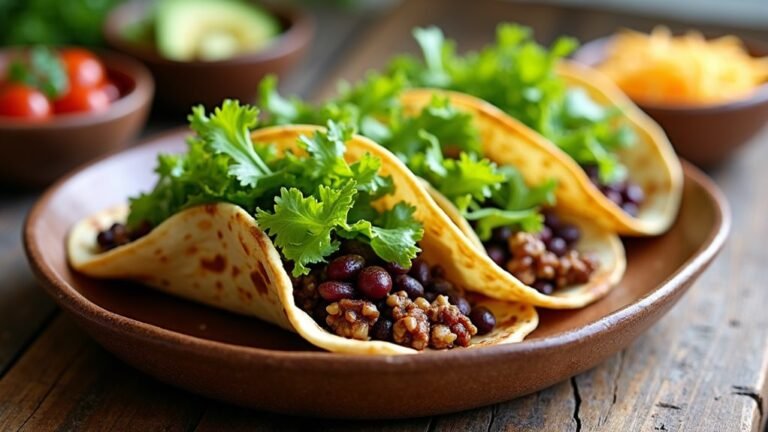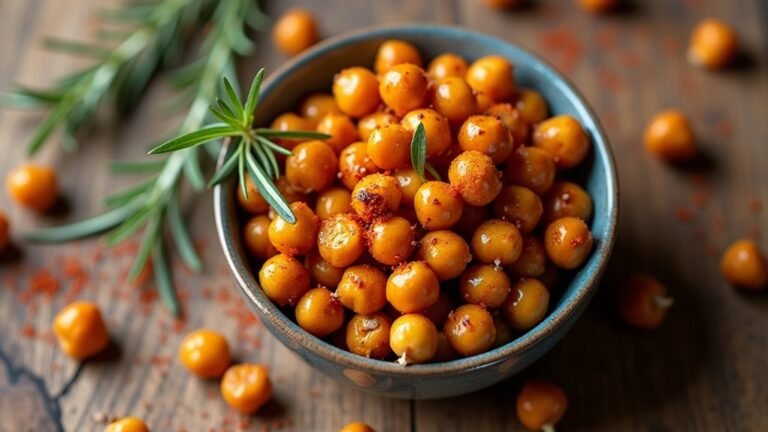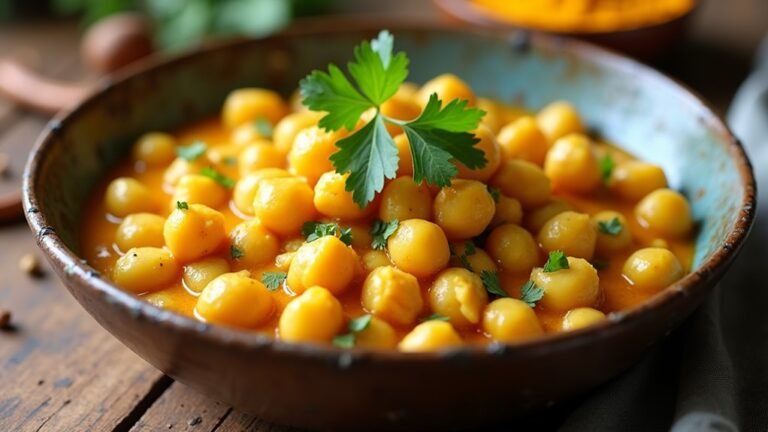Vegan Pad Thai Recipe: Sweet and Savory Delight
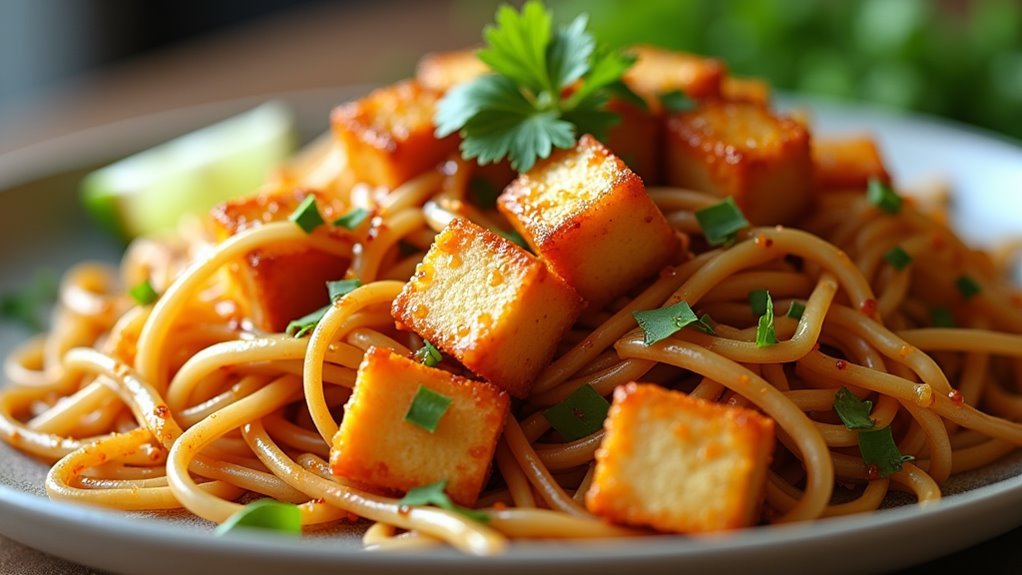
Few dishes balance simplicity and complexity like Vegan Pad Thai. It may seem like just another noodle dish, but the sweet and savory blend sets it apart.
Picture chewy rice noodles mingling with crispy tofu and fresh bean sprouts in a tangy tamarind sauce. It's not only about flavors; it's the experience of crafting something nutritious and satisfying.
Curious about achieving this balance? Let's explore the steps to mastering this timeless recipe.
Key Takeaways
- Vegan Pad Thai combines sweet, tangy, and savory flavors using tamarind sauce and brown sugar.
- Firm tofu adds protein and texture, while rice noodles provide a chewy base.
- Bean sprouts contribute freshness and crunch, balancing the flavors.
- The dish is quick to prepare with prepped ingredients and medium-high heat stir-frying.
- This plant-based recipe is environmentally friendly and suitable for all cooking levels.
Recipe
Vegan Pad Thai is a simplified yet flavorful dish that captures the essence of traditional Thai cuisine with just five key ingredients. This recipe highlights the harmonious blend of sweet, sour, and umami flavors, making it a delightful meal for those who appreciate plant-based cooking. The combination of chewy rice noodles, crispy pan-fried tofu, and fresh bean sprouts ensures a satisfying texture and taste in every bite.
The preparation process is straightforward, making it an ideal dish for both novice and experienced home cooks. The focus is on creating a well-balanced sauce using tamarind and brown sugar, which coats the noodles perfectly. By preparing all the ingredients before starting to cook, you'll be able to execute the dish efficiently, allowing you to enjoy a warm and delicious meal in no time.
Ingredients:
- 8 oz rice noodles
- 14 oz firm tofu
- 4 tbsp tamarind sauce
- 2 tbsp brown sugar
- 2 cups bean sprouts
To make Vegan Pad Thai, begin by soaking the rice noodles in warm water for about 30 minutes until they become pliable. Meanwhile, press the tofu to remove excess moisture, then cube and pan-fry it until golden brown.
In a wok or large skillet over medium-high heat, combine the tamarind sauce and brown sugar, stirring until the sugar dissolves. Add the drained noodles and stir-fry until they're tender and well-coated with the sauce. Finally, incorporate the fried tofu and bean sprouts, cooking for an additional 2-3 minutes until the sprouts are slightly wilted but still crisp. Serve immediately for the best flavor and texture.
For optimal results, avoid oversoaking the noodles as they'll continue to soften during cooking. If tamarind sauce is unavailable, a mix of lime juice and a splash of soy sauce can serve as a substitute.
Remember that the cooking process is swift, so having all ingredients prepped in advance is crucial for a seamless and enjoyable cooking experience. Enjoy your Vegan Pad Thai while the noodles are hot and the bean sprouts maintain their delightful crunch.
Cooking Steps
Get ready to create a delicious vegan Pad Thai by starting with soaking your rice noodles in warm water, which softens them perfectly for stir-frying.
While they soak, press and cube your tofu, then fry it until golden brown for that irresistible crispy texture.
In a hot wok, you'll dissolve the brown sugar in tamarind sauce, stir-fry your noodles until they're tender and coated, and finally, add tofu and bean sprouts for a vibrant, satisfying finish.
Step 1. Soak Noodles in Warm Water
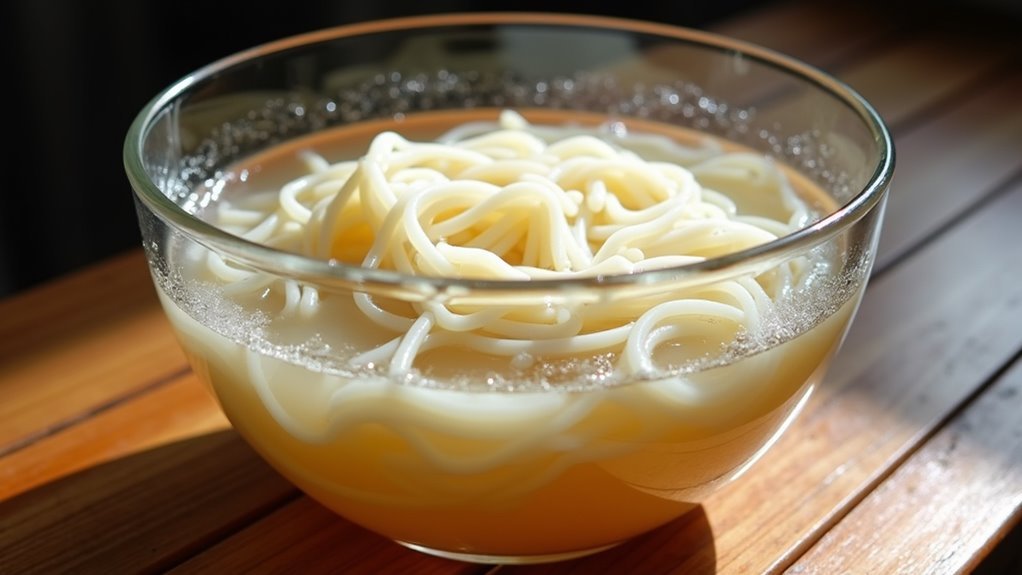
Soaking the rice noodles in warm water is a crucial step to ensure they reach the perfect texture for your vegan Pad Thai. You'll want to immerse them for about 30 minutes. This softens the noodles, making them pliable yet firm enough to soak up all the delicious flavors later on.
As you wait, feel the excitement build for the mouthwatering dish you're about to create. It's important not to rush this step; patience will reward you with noodles that are neither too firm nor too mushy. Stir them gently every so often to prevent clumping.
Once they're ready, drain them well, so they're not soggy. Your noodles are now set to become the star of a delightful, plant-based meal!
Step 2. Press and Cube Tofu
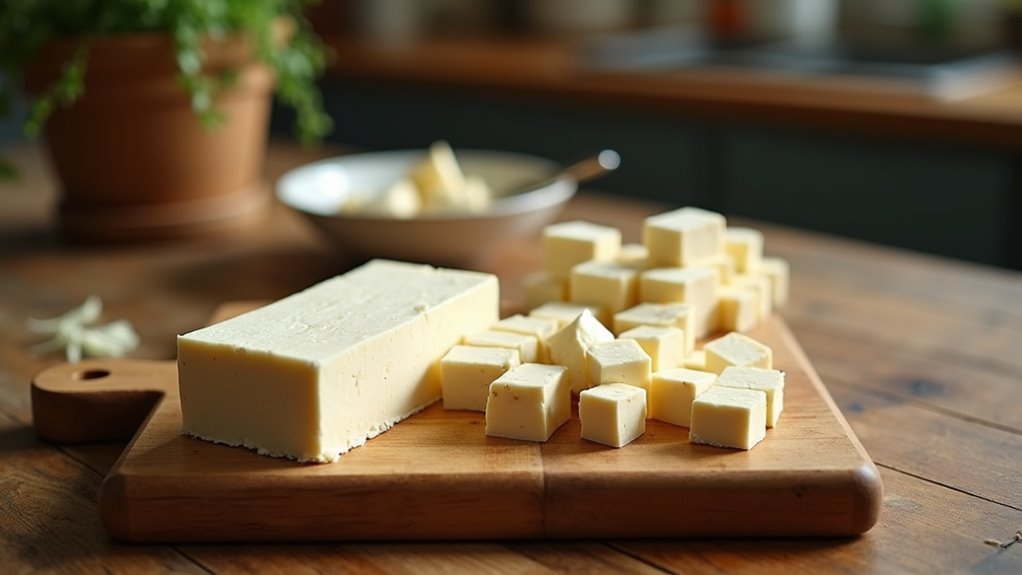
To prepare the tofu, start by pressing it to remove excess moisture, which helps achieve a firmer texture when cooked.
You'll love how this simple step transforms your tofu into golden, crispy cubes that are perfect for soaking up flavors! Place the tofu block between two plates, and weigh it down with something heavy like a can or book. Let it sit for about 20 minutes.
This ensures any extra water is squeezed out, giving you the perfect base for your vegan Pad Thai.
Once pressed, cut the tofu into bite-sized cubes.
Now, you're ready to pan-fry them until they're beautifully golden brown. This step is where the magic happens, creating a deliciously crispy exterior that contrasts beautifully with the soft interior.
Enjoy every bite!
Step 3. Dissolve Sugar in Tamarind Sauce
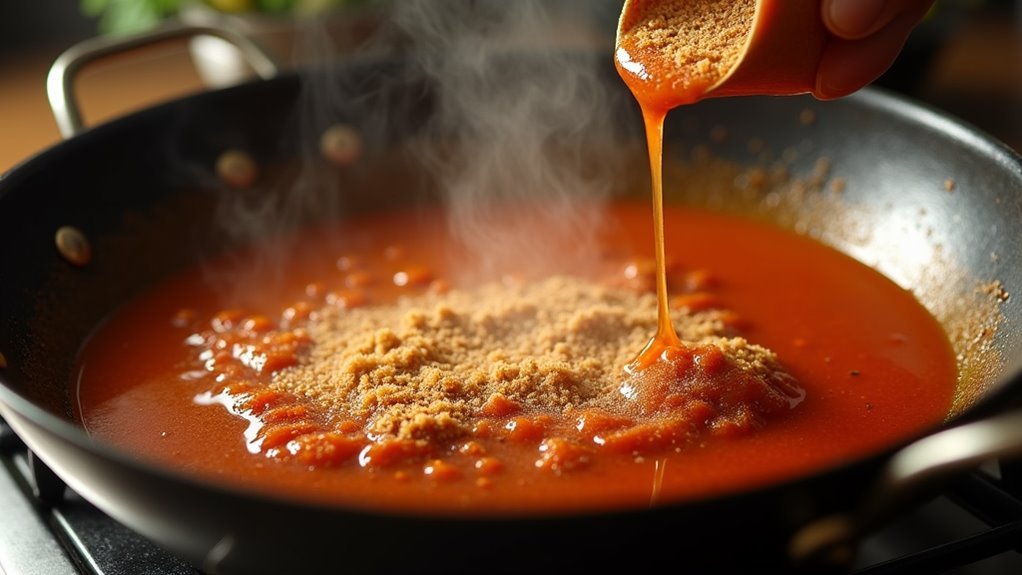
In your wok or large skillet, heat the tamarind sauce over medium-high heat, creating the perfect base for your Pad Thai.
As the sauce warms up, sprinkle in the brown sugar.
Watch with excitement as the sugar dissolves into the tamarind, transforming the mixture into a glossy, aromatic blend.
Stir gently and continuously, ensuring the sugar melts completely and melds with the sauce.
You'll notice the tamarind's tanginess marrying perfectly with the sweetness, creating a fragrant symphony that fills your kitchen.
This step is crucial for achieving that classic sweet and savory balance in your Pad Thai.
Don't rush it—letting the flavors meld here sets the stage for a delightful dining experience.
Your taste buds are in for a treat!
Step 4. Stir-Fry Noodles With Sauce
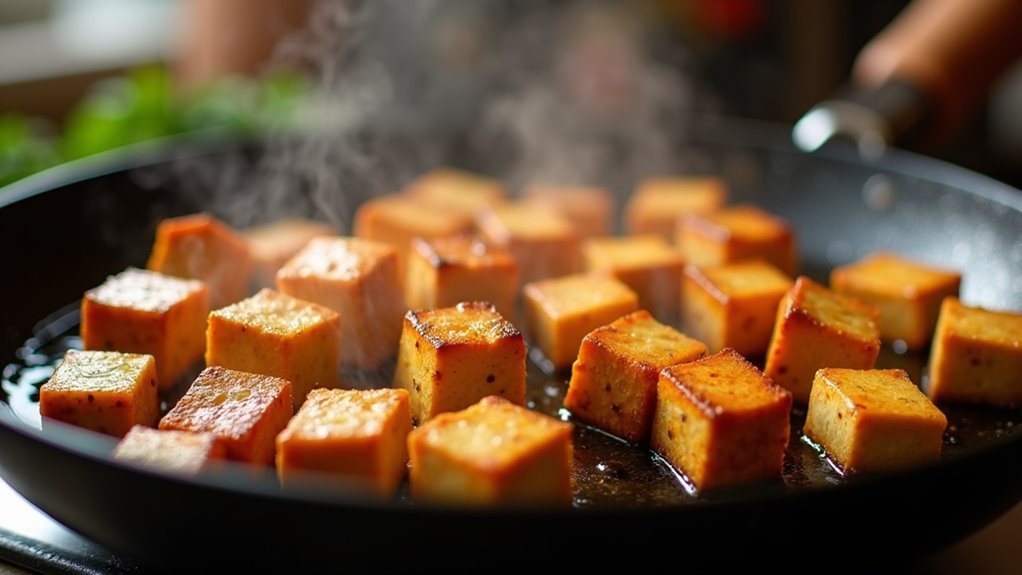
Once your tamarind and sugar blend is ready, it's time to bring in the rice noodles.
Get excited because this is where the magic happens! Drain your pre-soaked noodles, then add them to the hot wok with the sauce mixture.
Watch as they soak up the delicious flavors, transforming into silky, tangy strands. Use a pair of tongs to stir-fry them, ensuring every noodle gets coated evenly.
The heat should be medium-high, allowing the noodles to cook quickly without sticking. Keep them moving to achieve that perfect tender texture.
You'll see the noodles turn glossy as they absorb the sauce. In just a few minutes, your noodles will be bursting with flavor, ready to be paired with the next ingredients.
Step 5. Add Tofu and Sprouts
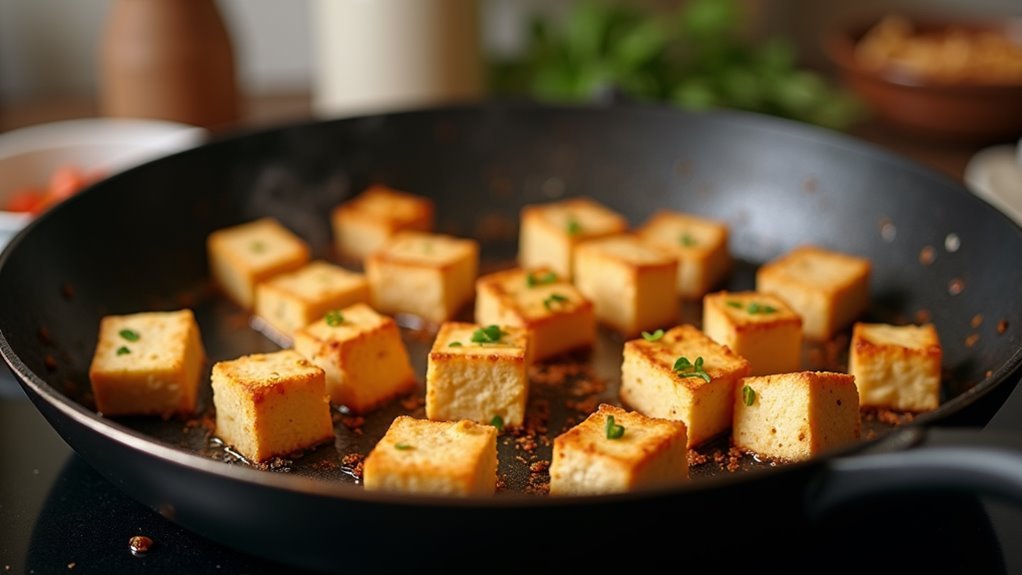
Now that your noodles are perfectly coated and glistening, it's time to elevate the dish with tofu and bean sprouts.
First, add your golden brown tofu cubes to the noodles, stirring them gently to ensure every piece is infused with the tangy sauce. The tofu adds a delightful texture and absorbs the flavors beautifully, making each bite a savory treat.
Next, toss in the fresh bean sprouts. They're not just a garnish; they bring a refreshing crunch and a hint of sweetness, balancing the dish's flavors perfectly.
Stir everything together for 2-3 minutes. As the sprouts cook, they'll soften just enough while still retaining their crispness. This step is crucial for achieving the perfect harmony in your vegan Pad Thai.
Enjoy!
Final Thoughts
With a few simple ingredients and a touch of creativity, you can transform your kitchen into a hub of Thai culinary delight.
Embrace the vibrant flavors of vegan Pad Thai, where each bite is a harmonious blend of sweet, savory, and crunchy textures.
You've journeyed through the recipe, experiencing the joy of creating something both delicious and plant-based. It's a testament to how accessible and satisfying vegan cooking can be.
Take pride in knowing you've crafted a dish that's not only tasty but also kind to the planet.
Share this delightful meal with friends and family, and inspire them to explore the wonders of vegan cuisine.
Frequently Asked Questions
Can I Use Other Types of Noodles for This Recipe?
Absolutely, you can use different noodles for this recipe!
While rice noodles are traditional, swapping them for zucchini noodles or soba noodles brings a fun twist. Each offers a unique texture, adding to the excitement of your dish.
Just make sure to adjust cooking times accordingly, so you don't end up with mushy noodles.
Experimenting with different types can elevate your pad Thai experience, keeping the flavors fresh and your taste buds thrilled!
What Can I Substitute for Tofu if I Have a Soy Allergy?
You've got options if you can't use tofu!
Consider swapping it with chickpeas, mushrooms, or even seitan if you're not sensitive to gluten. Chickpeas add heartiness, mushrooms bring an earthy flavor, and seitan offers a chewy texture.
Just remember to cook them well to absorb the sauce's deliciousness. Don't be afraid to experiment and find what suits your taste.
Dive into cooking and enjoy crafting a flavorful dish tailored just for you!
How Do I Store Leftover Pad Thai for Later?
You've got leftover Pad Thai? Lucky you!
Store it in an airtight container in the refrigerator, and it'll stay fresh for up to three days.
When you're ready to enjoy it again, just reheat it in a skillet over medium heat, adding a splash of water to keep the noodles from sticking.
Stir occasionally until the Pad Thai is heated through, and you're back to savoring those delicious, vibrant flavors!
Can I Add Vegetables or Other Proteins to This Dish?
Imagine your dish as a vibrant canvas, ready for your creative touch! You can absolutely add vegetables or other proteins to this Pad Thai.
Toss in colorful bell peppers, snap peas, or carrots for a burst of freshness. Consider adding tempeh or seitan for extra protein.
Stir-fry these additions to your liking before mixing them with the noodles. This flexibility lets you tailor the dish to your taste, making it uniquely yours.
Enjoy the burst of flavors!
Is There a Way to Make This Dish Less Spicy?
You can absolutely make this dish less spicy! Just skip the chili flakes or any spicy ingredients you might add.
If the tamarind sauce has heat, you can dilute it with a bit of soy sauce or lime juice to tone it down.
Feel free to experiment with a touch of coconut milk for a creamy, mild twist.

